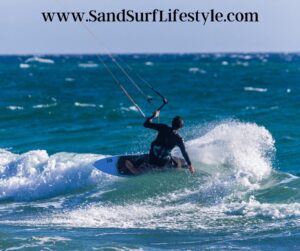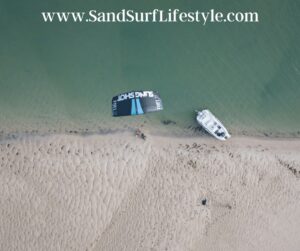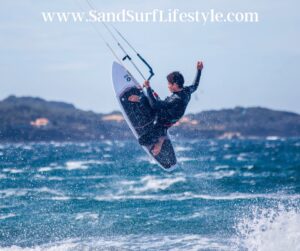What Size Kitesurfing Kite Do I Need? (Kitesurfing Kite Size Information)
Kitesurfing, also known as kiteboarding, is an extreme sport that involves a rider harnessing the power of the wind to use a large kite to be pulled across the water, land, or snow on a board. One of the reasons that kitesurfing is so popular is that it combines various aspects of surfing, windsurfing, skateboarding, snowboarding, and wakeboarding. This sport has been gaining notoriety and popularity amongst thrill-seekers around the world who want more fun and adventure than what many other sports can provide. The key to kitesurfing is knowing what size and type of Kite to use, and I’m here to help you with that.
You should use a larger kite for lighter winds, a medium more for medium winds, and a smaller kite for stronger winds. Your weight should also be taken into consideration when selecting a kite. Most kites are designed with a weight of 75 kilograms (165 lbs.) in mind. For every 10 kilograms (22 lbs.) more that you weigh, you can subtract 1 m/s of expected speed from the kite. You can add 1 m/s force every 10 kilograms (22 lbs.) you are under 75 kilograms (165 lbs.).
In this article, we are going to examine each of the kite sizes and the wind conditions in which you will be kitesurfing. Knowing which kites you should use in different wind conditions will help you to decide which size kite will work best for you. I will also take a brief look at the history of surfing, and I will also include a section that will list some of the best kitesurfing kites that you are available to purchase right now. By the end of this article, we’ll know which height is perfect for you and your kitesurfing needs.
Which Kite Is Right For the Wind Conditions?
 Looking for the right kitesurfing kite can be somewhat confusing, especially if you are new to the sport. However, if you know which kites are right for the different wind conditions you will be facing, you can eliminate most of the confusion involved in selecting the right kite. Per the website Windy, here is a guide for matching kits size to wind conditions :
Looking for the right kitesurfing kite can be somewhat confusing, especially if you are new to the sport. However, if you know which kites are right for the different wind conditions you will be facing, you can eliminate most of the confusion involved in selecting the right kite. Per the website Windy, here is a guide for matching kits size to wind conditions :
● Large kite for lighter winds (14–18 m) — 3–7 m/s.
● Medium kite for medium winds (11–13 m) — 7–9 m/s.
● Small kite for higher winds (5–9 m) — 9–13 m/s.
What Should You Ask Yourself?
When you are selecting your kite for kitesurfing, there are four questions that you should ask yourself before making your decision. However, it is important to keep in mind that smaller kites are usually better for beginning kite surfers. When referring to kitesurfing and which kite is right for you, size matters. A few of the questions that you should ask when selecting a kite include:
● How much do you weigh?
● Is this your first kite, or are you adding to your quiver?
● What are the conditions in which you will be able to ride?
● What style of kite do you prefer?
Is This Your First Kite or Are You Adding To Your Quiver?
When you are looking for the perfect kitesurfing kite, your experience with the sport has quite a bit to do with the kite you select. According to Mac Kiteboarding, the first kite that you select should be an all-around mid-range kite that is a good match for your weight. This will help you to maximize your water time and most of the conditions in which you will be kitesurfing. An all-around mid-range kiteboarding quiver will consist of the following elements:
● Mid-range kite
● High wind kite
● Light wind kite
If you are a beginner at kitesurfing, the website kitesurfist.com recommends that your first Kite should be a bow kite. There are also several things that you need to take into consideration when selecting your first Kite. Your first Kite should include the following qualities:
● It should have good stability and good depower.
● The kite should be easy to relaunch.
● Your Kite needs to have a large wind range
● The safety system should be easy to use.
● Choose an adequate size given weight/wind/board size
● The kite should also be no older than three years.
Is kitesurfing dangerous? Find out here.
How Does Your Weight Affect Your Kite Choice?
 Two things factor into choosing the right kitesurfing kite that takes precedence over most of the other factors that you will consider. We have already discussed one of them, which is matching the right kite to the right wind conditions. The other factor that you should consider when selecting a kite is your weight. Most kite manufacturers base the wind range they advertise on a kite surfer weighing 75 kilograms, but for every 10 kilograms of weight difference, you can add or subtract one m/s for the wind speed.
Two things factor into choosing the right kitesurfing kite that takes precedence over most of the other factors that you will consider. We have already discussed one of them, which is matching the right kite to the right wind conditions. The other factor that you should consider when selecting a kite is your weight. Most kite manufacturers base the wind range they advertise on a kite surfer weighing 75 kilograms, but for every 10 kilograms of weight difference, you can add or subtract one m/s for the wind speed.
According to the kitesurfing size chart, here are the different sizes of kites that a kite surfer weighing 75 kilograms should select for each range of wind speeds. However, you should remember to adjust accordingly, depending on if your weight is above or below 75 kilograms. You will need to deduct 1 m/s from the kite’s speed rating for every 10 kilograms that you weigh more than 75 kilograms, android you can add 1 m/s force every 10 kilograms you weigh less than 75 kilograms.
● 12 m kite wind range is 7-12 m/s.
● 10 m kite wind range is 9-14 m/s.
● 9 m kite wind range is 9-14 m/s.
● 7 m kite wind range is 10-16 m/s.
*To convert your weight from pounds to kilograms, divide your weight by 2.2, because a kilogram is the equivalent of 2.2 pounds.
What Are the Best Kites You Can Buy?
Even though choosing a kite for kitesurfing is a matter of personal preference that requires quite a bit of thought and consideration, it never hurts to have the recommendations and suggestions of those who have more kitesurfing experience than you. They have more knowledge regarding what works, as well as what doesn’t work. The people at The Adventure Junkies have compiled a shortlist of the top five kites that are available to purchase now. They include the following:
The History of Kitesurfing (Kiteboarding)
The origins of kitesurfing can be traced back to the 1800s, according to the Kiteboarding Handbook, when George Pocock started using large kites to assist him in propelling carts on land and ships on the water. George Pocock used the same four-line system that modern kite surfers use today. Pocock wanted to find an alternative method to using horses because of the horse tax that was quite unpopular at the time. He was successful, as the carts and ships were able to travel upwind, and the kites could fly for sustained periods.
Fast forward to October of 1977 when Gijsbertus Adrianus Panhuise of the Netherlands obtained the first patent for kitesurfing. He wanted to invent a sport in which he could use the power of the wind to pull him by using a parachute attached to a harness while he was standing on a floating board. However, there was no interest in his new sport. Between the late 1970s and the early 1980s, Bruno Legaignoux and Dominique Legaignoux developed and patented some of the kite designs that are still used in kitesurfing today. Cory Roeseler is considered to be the father of modern kitesurfing because he developed the KiteSki system in 1993.
Conclusion
 Kitesurfing is a fun and exciting sport that combines elements of surfing, windsurfing, skateboarding, snowboarding, and wakeboarding. However, choosing the right kite can potentially be a difficult decision. The most significant factors that you should keep in mind are that the size of your kite will be affected by both your weights and the winds conditions in which you will be kitesurfing. I hope that I have been able to provide some insight into your ability to choose the best kite for you.
Kitesurfing is a fun and exciting sport that combines elements of surfing, windsurfing, skateboarding, snowboarding, and wakeboarding. However, choosing the right kite can potentially be a difficult decision. The most significant factors that you should keep in mind are that the size of your kite will be affected by both your weights and the winds conditions in which you will be kitesurfing. I hope that I have been able to provide some insight into your ability to choose the best kite for you.
One thing to keep in mind is that there is a 30-hour rule in kitesurfing, meaning that it will take you approximately 30 hours of kiteboarding before you are an independent kite surfer. You should take this time to get an idea of what kite works best for you before committing to one. If the first kite you select doesn’t work for you, relax. You will eventually find one that can meet your kitesurfing needs. Once you have selected the kite that is right for you, you will be kitesurfing like a seasoned pro in no time!
Related Questions
What are the best kitesurfing kites for beginners? Choosing a kite for kitesurfing can be a difficult and confusing task. This can be even more confusing if you are a beginner. Once you have decided to take the leap and purchase your kite, here are four of the top-rated and most highly recommended kites for beginners:
● Cabrinha Switchblade – Best selling beginner kite of all time
● Duotone Neo – Lightweight and great for learning and improving
● Slingshot Rally – Powerful with the best relaunch
● Ozone Catalyst – Also lightweight and well-suited for beginners
What are the best spots in the United States to go kitesurfing? As is the case with many other water sports, there are plenty of places to go kitesurfing in the United States. If you want to find the best spots in America to go kitesurfing, try these five spots:
● Cape Hatteras, Hatteras Island, Outer Banks
● Key West, Florida
● South Padre Island, Texas
● Columbia Gorge, Hood River, Oregon
● Muskegon, Michigan

Please note: This blog post is for educational purposes only and does not constitute legal or medical advice. Please consult a legal expert or medical professional to address your specific needs.

